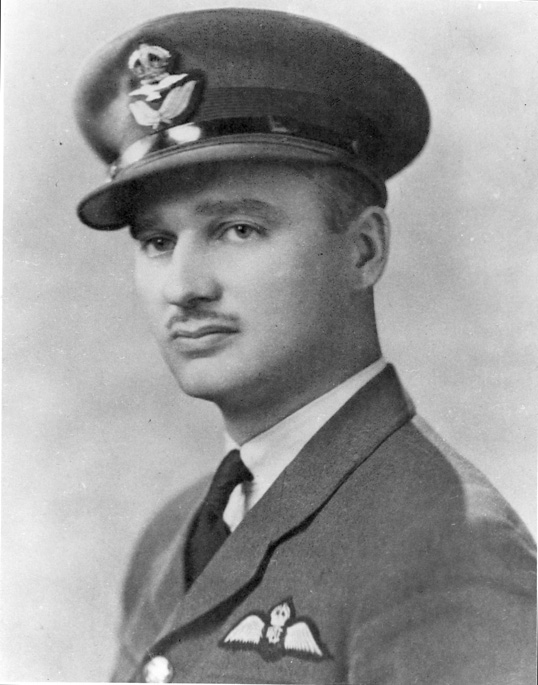
Photograph of Louis Dubuc from the Canadian Virtual War Memorial
On a summer afternoon in 1929, a Lockheed Vega cabin plane circled low over downtown Fort Saskatchewan. Its pilot, the intrepid and famous flyboy, Wilfrid “Wop” May, brought the plane close to the Williamson Block on 102 Street to allow his passenger, Louis Dubuc, to drop a handwritten note on the roof of the building. Dubuc’s letter, which missed its target by two feet, was intended for his father, W.A. Dubuc, co-owner of Dubuc & Gordon Hardware. The letter’s contents are unknown today but the event set the stage for the first person born in Fort Saskatchewan to receive a pilot’s license and land an airplane in town.
Louis Romeo Dubuc, born to William and Eveline Dubuc on June 10, 1907, in Fort Saskatchewan, studied flying under Wop May through the Edmonton & Northern Alberta Aero Club. The club had formed just two years earlier, in 1927, with May as the first club president. On August 26, 1929, a little over a week after the letter drop, Dubuc once again soared through the “misty skies” above Fort Saskatchewan; this time on a solo mission. He circled the town for a “little while in the air banking, turning, etc. and then away.”[1] The next morning, Dubuc and the hum of his De Havilland’s engine returned to the Fort, much to the delight of the townsfolk. The young pilot decided to land his aircraft this time and put it down on the flood plain behind the old Provincial Gaol. A large crowd gathered with a “hurry-scurry down to the trail to see all and miss nothing.”[2] Although, landing an airplane in town seemed a “lovely feat,” to one local woman she also lamented that Dubuc “did delay dinner so.”[3] Dinner must not have been delayed for long, as Dubuc made only a short stay and took off on his makeshift runway to the cheers of the gathered crowd.
A few months later, on October 3, Town Council made a motion to “recognize the ability of Louis Dubuc being the first person raised in the town to fly and land in the town.”[4] Celebrations would have to wait, however, as Dubuc managed to break his arm cranking an airplane in December, landing him in an Edmonton hospital to convalesce. On Friday, February 7, 1930, the town finally held a public meeting where Mayor W.H. White presented Louis Dubuc with an engraved gold medal for his aeronautical feats.
Fort Saskatchewan’s first pilot departed for the east not too long after receiving his award. In Ottawa, he worked as a ground crew member for a commercial airline before joining the R.C.M.P. when they formed an air services branch in 1937. On November 28, 1939, Dubuc enlisted in the Royal Canadian Air Force.
At 9:30 a.m., on September 27, 1941, Flight Lieutenant Louis Dubuc completed the first leg of a trans-Atlantic flight ferrying a Lockheed Hudson bomber from Canada to Britain. He took off at 1:25 p.m. from Daldonnel Aerodrome in Dublin to complete the trip, accompanied by Sergeant Goodman, as an observer, and S.R. Kenny, the radio operator. At approximately ten minutes to 2:00 p.m., Dubuc’s aircraft was last heard over Dundalk Bay before it crashed into the mountainside at Jenkinstown, Ireland, killing all three Canadian service members immediately. Dubuc is buried at St. Mary’s Catholic Cemetery in Newry, Northern Ireland. His funeral, on October 1, 1941, featured a full regimental band and escort provided by the 5th Welsh Division of Newry.[5]
[1] Fort Saskatchewan Record, August 26, 1929.
[2] Ibid.
[3] Ibid.
[4] Fort Saskatchewan Record, October 16, 1929.
[5] Corcoran, I.D., Letter to Mrs. Margaret Dubuc, 1941. Accessed November 28, 2020. https://www.veterans.gc.ca/eng/remembrance/memorials/canadian-virtual-war-memorial/detail/2690340











